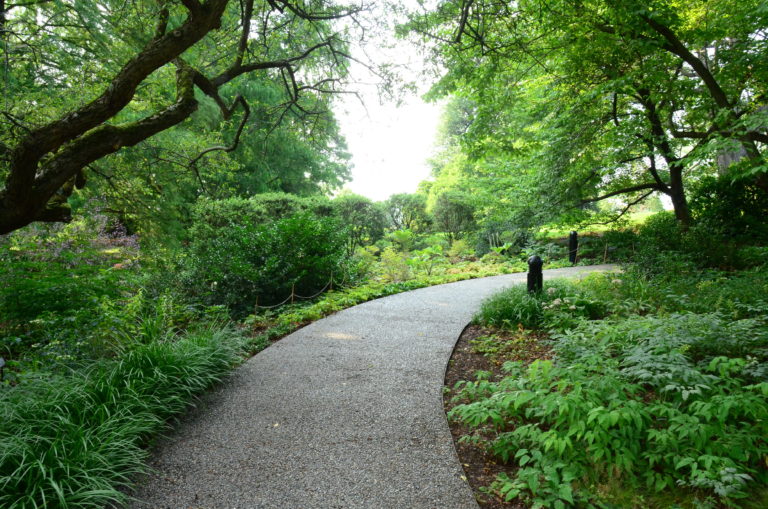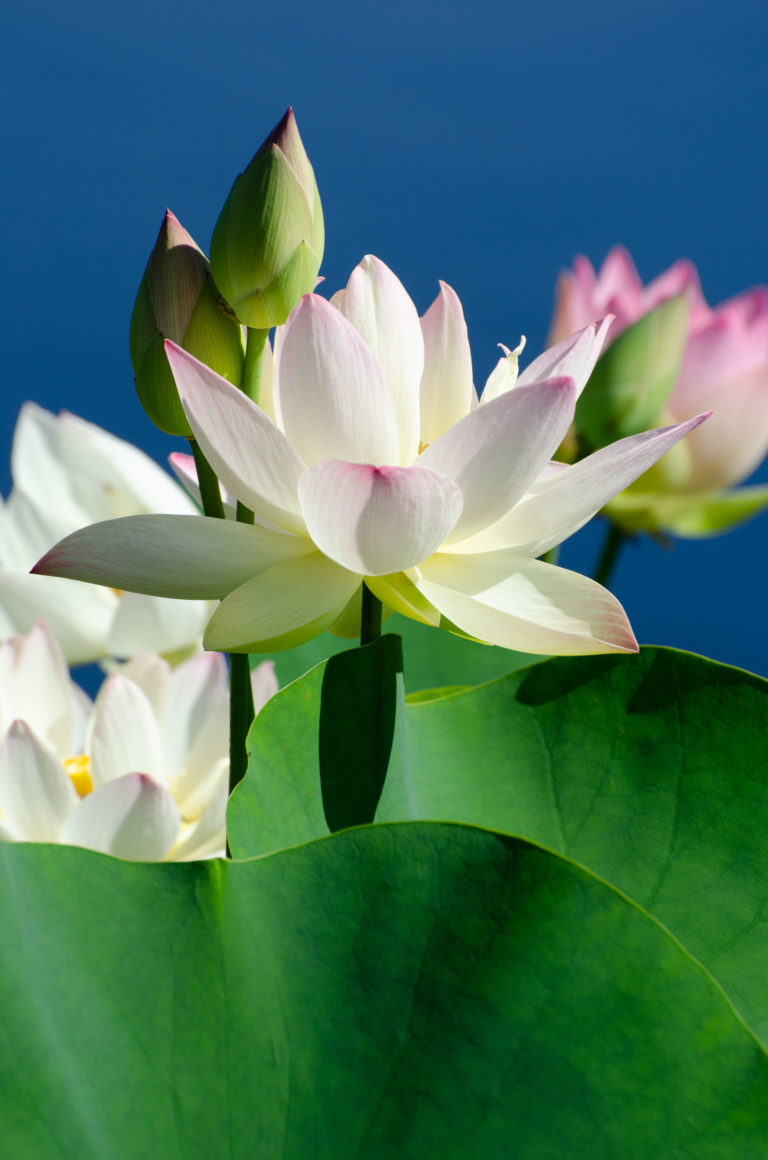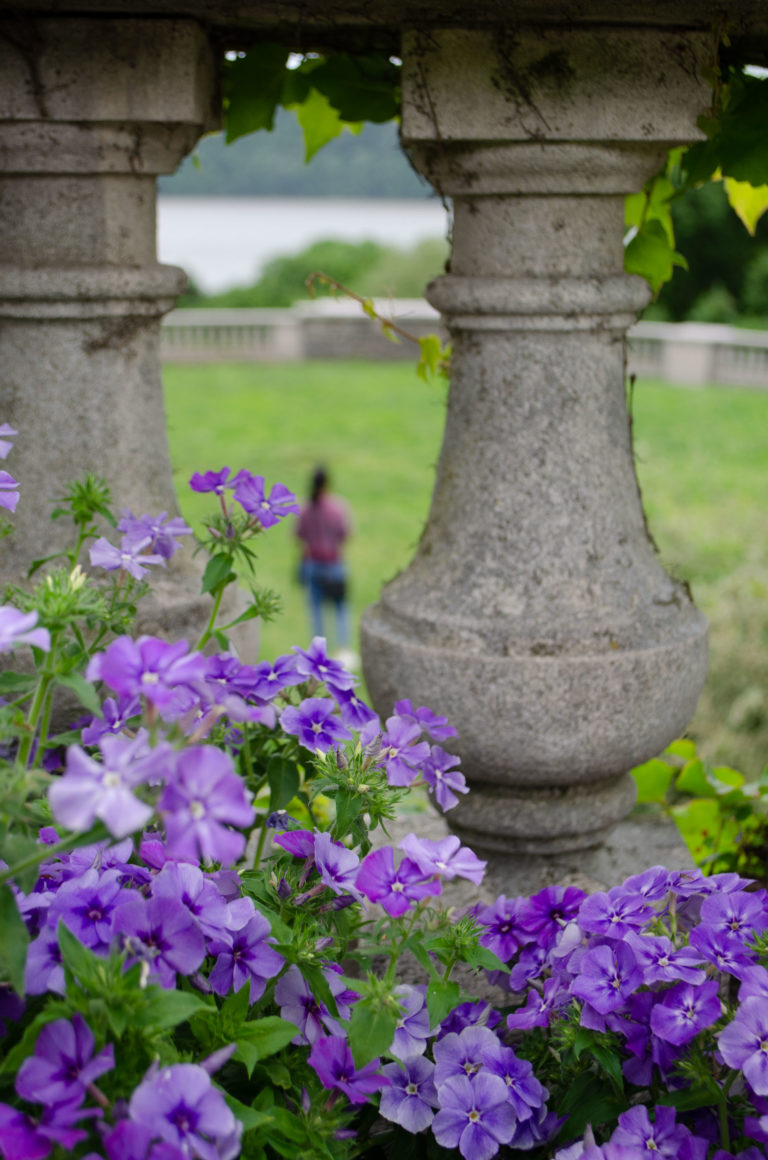
Shady Greens: Plants at the Entrance Walk and Shade Border
July 30, 2023The color green has many faces, like a 100-sided die. When looking across long beds of shade plants amongst the Entrance Walk, the newest garden area, and Shade Border, at the north end of the garden, I see many of these green-facets and varying textures. But they can be hard to appreciate—as a recent, exasperated visitor commented: “Gosh, all I see is green!” Well, they were right, but as we chatted about all the variations in green, I heard a growing appreciation of the lush, variable landscape. So, let’s talk about green, the textures of lovely shade plants and some combinations favored by the gardeners.

Starting at Wave Hill’s Entrance Walk winds a path that draws visitors through a gently wooded shade garden before concluding with a view of the Palisades and Pergola. Gardened by Kevin Hennessy, this area is still taking shape.

A lot of what Hennessy has focused on this year is breaking up large blocks of plants. About the area pictured here, he says “right here my job was to edit out some Asarum canadense (Canada wild ginger) and also break up the color by mixing in new plants like this Japanese-painted fern (Athyrium niponicum ‘Pictum’), Pulmonaria longifolia subsp. cevennensis (lungwort), Heuchera cv. (coral bells) and Vancouveria hexandra (inside-out flower). Now there are a lot of different textures happening here, where before it was just Asarum.”
Alone, Asarum canadense has the habit of getting overlooked; its leaves have a lovely cordate, or heart shape, but the fuzzy-tomentose coating makes them appear dull to some—a sort of “light-absorber.” But when contrasted by the glossy-green Polystichum acrostichoides (Christmas fern) and its fresh, kelly-green growth, the shiny fronds of this young fern provide bright color and reflected light. Balance is reached in this young planting’s composition.

Wave Hill has a large collection of Epimediums (barrenwort) which can be found throughout many garden areas. Plant nerd fact: many of these plants have a direct link to Harold Epstein, a prominent collector of the genus. Epstein, or his friends and family, have donated these plants to Wave Hill over the years. This block of Epimediums is broken up by some volunteer fronds of Athyrium filix-femina (lady fern). While unplanned, this fortuitous pairing creates a naturalistic moment.
Epimediums for a long time were uncommon in gardens, but recently have gained popularity. This genus brings a nod of color throughout the seasons—some fade to brilliant oranges and reds in the autumn, most have colorful new growth, and all produce delicate, fairy-like flowers of pink, white or yellow in spring. As Hennessy remarks, “there are many nice trees that bloom here, one after another through the spring. It’d be nice to pair some new plants with them (flowering trees).” Many of the flowering plants in this garden are in the pinkish/purple/yellow palette to reflect this vision.

One of Hennessy’s most recent additions is a beryl-colored foliage Actaea pachypoda 'Misty Blue' (doll’s eyes) grown from seed. A foot tall, it mingles at the base of the very tall, powdery-purple stemmed Thalictrum rochebrunianum (lavender mist meadow rue). The airy quality of the Thalictrum compliments the stout habit of the Actaea. Grounding this silvery corner is a large Quercus robur ‘Variegata’ (variegated English oak).

Moving north across Wave Hill to the Shade Border, Gardener Kyla Dippong cares for the four large beds that comprise this garden. Dippong describes this area as “being quiet, meditative, restful and unlike a flashy flower garden that is meant to excite and stimulate. The Shade Border is meant to calm. The idea is to have a variety of textures. You may not have a lot of color, but you have a variety of textures, tones and greens.”

Dippong draws visitors through the Shade Border with repeating swaths of plants—two that repeat are Penstemon digitalis ‘Husker Red’ (beardtongue) and Persicaria virginiana ‘Lance Corporal’ (jumpseed). Dippong introduced these two plants to this garden area in 2021; "this Persicaria virginiana ‘Lance Corporal’ has a little epaulet of burgundy on the leaf so I planted it with this Penstemon digitalis ‘Husker Red’ which has a burgundy stem and Heuchera ‘Bronze Wave’ (not pictured) that has a burgundy tone. Even though when you look across the palette it looks green; it picks up those different tones and textures.” Both of these native species seem to freely move around; Dippong recommends only adding them to the garden if you are prepared to manage them. Without thinning, these abounding plants will easily take over a garden bed.

Lance-like elliptical leaves of Sauromatum venosum (snake-lily) have undulating edges, creating a visual of movement. Each plant produces a singular leaf held atop a purple-mottled stem. A member of the aroid family, this plant provides a tropical look that is dynamic and breaks up the possibly familiar mix of native plants.

Asarum canadense is also used in this garden area. Here in a west-facing bed that receives sunlight, it has taken on a sun-kissed appearance that compliments the yellow flowers of Ligularia sibirica (Siberian leopard plant) and the chartreuse new-growth on Thuja plicata ‘Green Giant’ (arborvitae). Notice the mosaic of textures in the background, left to right, including Helleborus, Polygonatum, Athyrium and Epimedium.

No shade-plant conversation is complete without addressing variegation. Dippong’s preference: “I don’t use a lot of variegation, but this large plant, Sambucus nigra ‘Variegata’ (elderberry), was here when I started. When used sparingly, variegation adds a slightly different tone but doesn’t really change the palette.” The Sambucus is very large, receiving an extreme cutback every spring, but underneath is a mixture of complimentary textures. Grassy-like leaves with linear variegation of Disporum sessile ‘Variegatum’ (fairy bells) and lime-green, maple-like foliage of Actaea rubifolia (American bugbane).
The closer you look, the more is revealed. I hope you have enjoyed this shady respite from the thick of summer.

Jess Brey,
Ruth Rea Howell Senior Horticultural Interpreter



